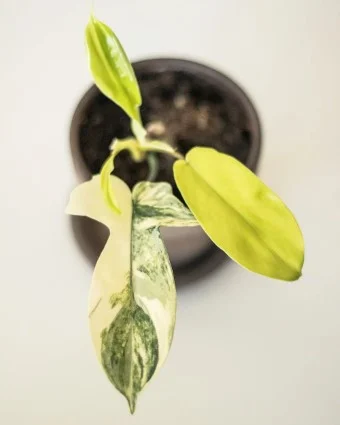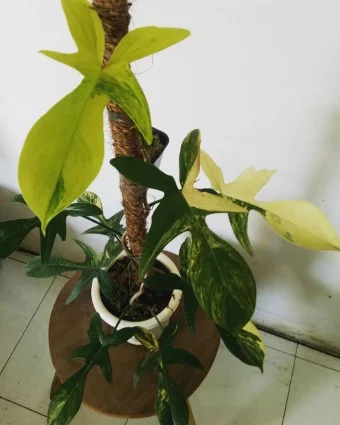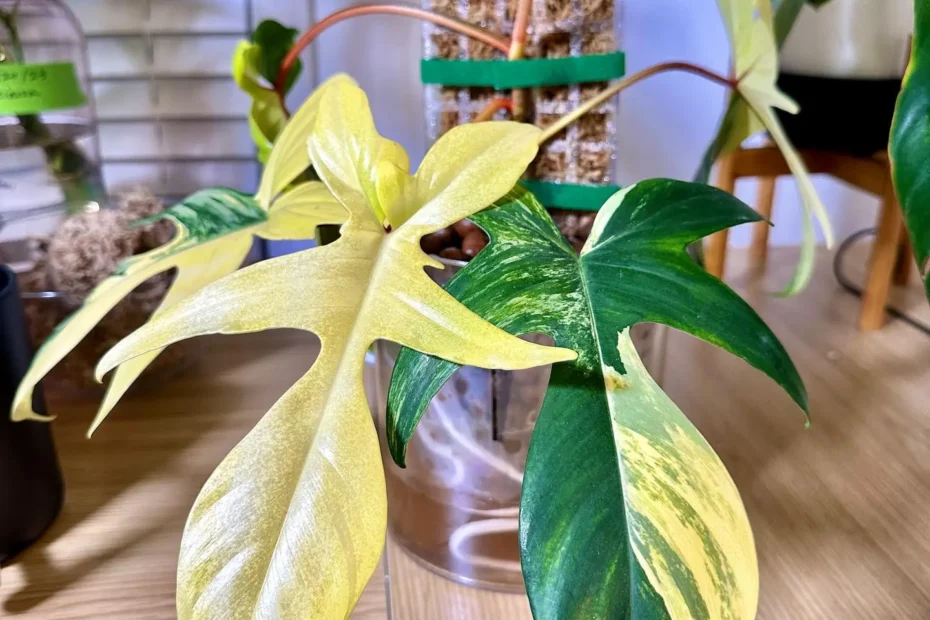Introduction
Imagine discovering a rare treasure trove, not of gold or jewels, but of exquisite, living greenery that transforms your living space into a vibrant oasis. That’s the enchantment of encountering the Philodendron Florida Beauty—a plant that marries the whimsical charm of its unique foliage with the robust vitality of its nature. My name is Anitha, and as a botanist and houseplant aficionado, I’ve nurtured dozens of Philodendrons over the years, each with their distinct personalities.
However, the Florida Beauty stands out not just for its striking variegated leaves that seem to paint the air with splashes of green and creamy white but also for its remarkable ease of care and potent air-purifying abilities. This plant isn’t just a visual treat; it’s a silent guardian that enhances your home’s aesthetic appeal while tirelessly working to improve your living environment.
In-Depth Care Florida Beauty Philodendron
Unlocking Lush Growth: The Ideal Light for Your Philodendron Florida Beauty
The secret to nurturing a thriving Philodendron Florida Beauty lies in finding its lighting sweet spot: bright, indirect sunlight. This resilient yet elegant plant flourishes under light conditions that mimic the dappled sunlight of its natural tropical habitat. Too much direct sunlight can scorch its magnificent leaves, leaving behind unsightly marks, while insufficient light may lead to leggy stems and sparse, slow growth.
For optimal growth and health, position your Florida Beauty near east or north-facing windows where it can bask in the gentle morning light or receive soft, ambient light throughout the day. South or west-facing windows can also accommodate this plant with the aid of sheer curtains or blinds, helping to diffuse the intense afternoon sun. This thoughtful placement ensures that your Philodendron receives just the right amount of light to maintain its vibrant foliage and robust growth, making it a striking addition to your indoor garden.
Watering Wisdom: How to Avoid Overwatering Your Philodendron Florida Beauty
The Philodendron Florida Beauty thrives with a balanced watering regimen that mirrors the natural ebb and flow of rainfall in its native tropical forests. The key to success lies in ensuring well-draining soil, which prevents water from stagnating around the delicate roots, a common cause of root rot in these plants. Before reaching for the watering can, check that the top inch of the soil is completely dry. This simple test safeguards against overwatering, ensuring that your plant receives moisture only as needed.
Watering frequency varies with the seasons—plan for more frequent watering in the warmer months when the plant is actively growing, and reduce frequency during the cooler, dormant period. Additionally, the size of the pot can influence watering needs; smaller pots dry out faster than their larger counterparts.
Look out for the telltale signs of overwatering, such as yellowing leaves or a mushy stem base, and signs of underwatering, like droopy or brown, crispy leaves. By tuning into these cues and adjusting your watering schedule accordingly, you can maintain the perfect level of hydration for your Philodendron Florida Beauty, ensuring its health and longevity.
Crafting the Perfect Home: The Ideal Soil Mix for Your Philodendron Florida Beauty
For your Philodendron Florida Beauty to truly flourish, a foundation of well-aerated, well-draining soil is crucial. Just as the right home enriches our lives, the right soil mix can radically enhance the health, growth, and vibrancy of your plant. This not only ensures proper moisture management to prevent root rot but also fosters an environment where roots can breathe and grow freely.
To create an ideal DIY soil mix, start with a base of peat moss or coco coir for moisture retention. Then, incorporate perlite and orchid bark in equal parts to add the much-needed aeration and drainage. This combination simulates the Philodendron’s native soil conditions, offering a balance of moisture retention and drainage that supports robust root health.
For those preferring convenience over custom mixes, several pre-made potting mixes are available that are formulated specifically for aroids like the Philodendron. These often include the necessary components such as perlite, pine bark, and peat, ensuring your Florida Beauty gets the perfect growing conditions without the guesswork.
Remember, the right soil mix is like a good home—it doesn’t just serve a basic need; it enhances growth, health, and overall well-being, making it a crucial step in your Philodendron Florida Beauty care routine.
Boosting Growth: A Strategic Fertilization Plan for Your Philodendron Florida Beauty
To ensure that your Philodendron Florida Beauty reaches its full potential, adopting a strategic fertilization plan is key. Fertilizer plays a critical role in supplementing the essential nutrients that might not be fully available in your plant’s soil, particularly if it’s been in the same pot for a while.
For the Florida Beauty, a balanced organic fertilizer, diluted to half its recommended strength, provides the perfect nutrient boost without overpowering the plant. Apply this gentle, nourishing mixture once a month during the spring and summer months, when the plant is in its active growing phase.
It’s essential to understand that while fertilization is crucial, there is such a thing as too much of a good thing. Over-fertilizing can lead to fertilizer burn, manifesting as brown, crispy leaf edges or a buildup of salt in the soil, which can adversely affect the plant’s roots. By adhering to a moderate fertilization schedule and observing your plant’s response, you can ensure that your Philodendron Florida Beauty not only survives but thrives, displaying lush, vibrant foliage as a reward for your care and attention.
Creating a Tropical Oasis: Humidity Needs for Your Philodendron Florida Beauty
The Philodendron Florida Beauty, with its tropical roots, naturally thrives in environments with higher humidity, mirroring the moist, dewy atmosphere of its native habitat. Though it’s adaptable to the average room humidity found in most homes, creating a more humid microclimate can encourage lush growth and vibrant leaf coloration.
To elevate humidity around your plant, consider using pebble trays filled with water placed directly under the plant’s container. This not only raises the moisture level in the immediate vicinity but also provides a more consistent humidity source. Alternatively, a room humidifier can offer a more controlled solution for adjusting humidity levels, benefiting not just your Philodendron but other houseplants as well.
Grouping plants closely together can also create a micro-environment of shared humidity, with each plant contributing to the collective moisture in the air. These simple adjustments can transform your home into a tropical oasis, providing the perfect conditions for your Philodendron Florida Beauty to flourish.
Expand Your Plant Family: Propagating Your Philodendron Florida Beauty


Propagating your Philodendron Florida Beauty is a rewarding way to multiply your collection or share this stunning plant with friends and family. The most effective method for this plant involves stem cuttings, which can be rooted in water or soil. Unfortunately, as this is a text-based guide, including actual pictures is not possible here, but below is a detailed step-by-step process you can easily follow:
- Choose a Healthy Stem: Look for a healthy stem with at least 2-3 leaves and a visible node (a small bump or blemish on the stem where leaves and roots grow). The node is critical as roots will develop from this point.
- Make the Cut: Using a clean, sharp pair of scissors or pruning shears, cut just below the node. A cut of about 4-6 inches in length is ideal, ensuring you have at least one node on the cutting.
- Prepare for Rooting: If you’re rooting in water, remove any leaves that would sit below the water line to prevent rot. For soil rooting, you can skip this step.
- Rooting in Water: Place the cutting in a jar of room temperature water, making sure the node is submerged. Change the water every few days to keep it fresh. Roots should begin to appear in 3-4 weeks.
- Rooting in Soil: Dip the cut end of your stem into rooting hormone powder to encourage root growth (optional). Plant the cutting in a pot filled with moist, well-draining potting mix, ensuring the node is buried. Keep the soil consistently moist but not soggy.
- Wait and Watch: Whether in water or soil, place your cutting in a warm location with indirect light. Rooting can take between 3-8 weeks. If in water, once roots have grown a few inches, you can transplant the cutting to a pot with soil.
- Transplanting: Gently plant your rooted cutting in the potting mix as described in the soil section above, being careful not to damage the new roots. Follow the care guide provided earlier for your newly propagated Philodendron Florida Beauty.
- Aftercare: Keep the soil moist and place the pot in indirect light as your new plant adjusts to its environment. You may notice slower growth at first as your cutting acclimates and focuses on root development.
Though patience is required, propagating your Philodendron Florida Beauty offers the joy of watching a new plant grow from a single cutting. It’s a simple, yet satisfying process that not only expands your plant family but also deepens your connection with these remarkable tropical beauties.
Philodendron Florida Beauty SOS: Identifying and Fixing Common Issues
Caring for a Philodendron Florida Beauty can occasionally come with its set of challenges, including yellowing leaves, brown spots, and stunted growth. However, with the right knowledge and approach, these issues can be addressed efficiently to restore your plant’s health.
- Yellowing Leaves: Often a sign of overwatering, yellow leaves can also indicate a nutrient deficiency. Ensure that your plant’s soil is well-draining to prevent waterlogged conditions. If overwatering is not the issue, consider applying a balanced, organic fertilizer to address potential nutrient shortages.
- Brown Spots on Leaves: This can suggest several problems, including fungal infections or sunburn. First, assess your plant’s location; if it’s receiving direct sunlight, relocate it to an area with bright, indirect light. For fungal concerns, reduce leaf wetness by watering the soil directly and increasing airflow around the plant. Fungicidal sprays may also be necessary for severe infections.
- Stunted Growth: Stunted growth can be a result of insufficient light, low humidity, or poor nutrition. Make sure your Philodendron is placed in an area receiving bright, indirect sunlight, and consider using a humidifier to increase humidity levels. Regular fertilization during the growing season should also promote healthy growth.
Implementing these solutions promptly can prevent minor issues from turning into major problems, ensuring that your Philodendron Florida Beauty remains a vibrant and thriving part of your plant collection. Remember, preventative care is often the best approach, so regularly inspect your plant for signs of distress and maintain optimal growing conditions to keep common issues at bay.
Florida Beauty Philodendron Advanced Care Tips
Reaching New Heights: Providing Support for Your Climbing Philodendron Florida Beauty
Climbing Philodendron varieties, including the exotic Florida Beauty, inherently seek support to grow upwards, mimicking their natural rainforest habitat. Incorporating a moss pole or trellis not only supports this vertical growth but also promotes larger leaf development, reflecting a more mature plant in the wild. To create your own moss pole, you will need sphagnum moss, a PVC pipe or wooden dowel, and some fishing line or twine.
Begin by soaking the moss in water until it’s fully hydrated. Then, wrap the moss around the pipe or dowel, securing it tightly with the fishing line at various intervals. Once your homemade moss pole is ready, gently guide your Philodendron’s stems towards it, using soft plant ties if necessary to encourage initial support. Over time, aerial roots will cling to the moss, anchoring the plant as it climbs.
Room to Grow: When and How to Repot Your Philodendron Florida Beauty
Philodendron Florida Beauty, like many houseplants, thrives when it’s not too cramped. Recognizable signs that your plant is ready for a new home include roots emerging from drainage holes or circling the surface of the potting mix, and slowed growth. Repotting is ideally done in the spring or early summer, allowing the plant to acclimate and grow during its active season.
To repot, select a new pot that is 1-2 inches larger in diameter than the current one and with ample drainage. Begin by gently removing your plant from its current container, brushing off excess soil and inspecting the roots for any signs of rot or disease, trimming as necessary. Prepare the new pot by filling the bottom with a well-draining potting mix formulated for tropical plants.
Place your Philodendron in the new pot and fill around it with more potting mix, pressing lightly to secure the plant without compacting the soil. Water thoroughly to settle the plant and the soil, and keep it in a well-lit, warm spot without direct sunlight for a few weeks to recover. Repotting not only provides fresh nutrients and room to grow but also an opportunity to check the health of your plant’s root system.
Conclusion
In summary, ensuring your Philodendron Florida Beauty thrives involves providing it with ample indirect light, maintaining high humidity, a well-draining soil mix, regular watering while avoiding waterlogging, and timely fertilization. Support its climbing nature with a moss pole or trellis for optimal growth. Detect and address any signs of distress early to keep your plant healthy.
We’d love to hear about your Philodendron Florida Beauty care experiences! Share your stories, tips, or questions in the comments below or on social media. Hungry for more? Visit Houseplant Central and The Spruce for comprehensive guides and advanced care tips for your tropical favorites.
